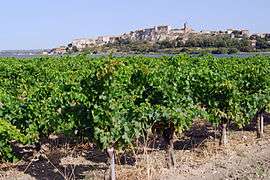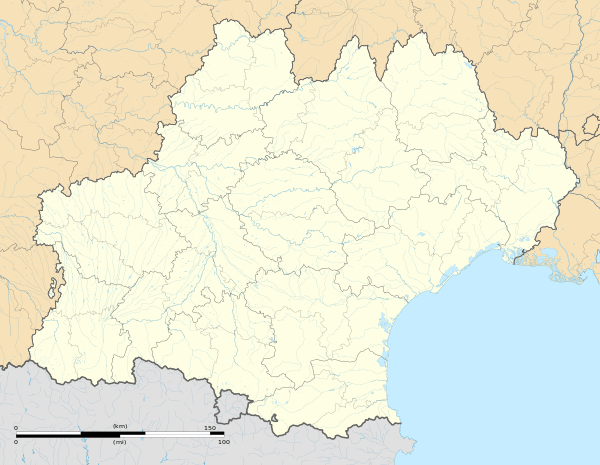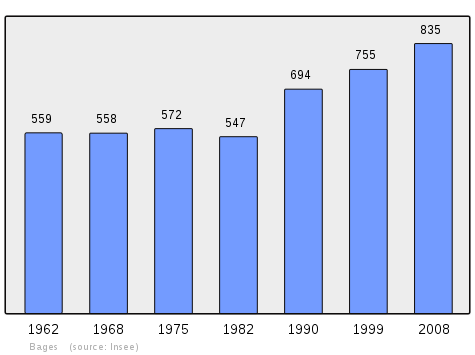Bages, Aude
Bages (Bajas in Occitan) is a commune in the Aude department in the Occitanie region of southern France.
Bages | |
|---|---|
 A general view of Bages, seen from a vineyard | |
.svg.png) Coat of arms | |
Location of Bages 
| |
 Bages  Bages | |
| Coordinates: 43°07′27″N 2°59′30″E | |
| Country | France |
| Region | Occitanie |
| Department | Aude |
| Arrondissement | Narbonne |
| Canton | Narbonne-2 |
| Intercommunality | Le Grand Narbonne |
| Government | |
| • Mayor (2008–2020) | Marie Bat |
| Area 1 | 12.53 km2 (4.84 sq mi) |
| Population (2017-01-01)[1] | 803 |
| • Density | 64/km2 (170/sq mi) |
| Time zone | UTC+01:00 (CET) |
| • Summer (DST) | UTC+02:00 (CEST) |
| INSEE/Postal code | 11024 /11100 |
| Elevation | 0–190 m (0–623 ft) (avg. 36 m or 118 ft) |
| 1 French Land Register data, which excludes lakes, ponds, glaciers > 1 km2 (0.386 sq mi or 247 acres) and river estuaries. | |
The inhabitants of the commune are known as Bageois or Bageoises.[2]
Geography

Bages is located in the urban area of Narbonne on the Canal de la Robine and the Étang de Bages-Sigean (Bages-Sigean Lake) some 6 km south-west of Narbonne and 9 km north of Portel-des-Corbières. Access to the commune is by the D6009 road from Narbonne which passes through the centre of the commune and continues south to Salses-le-Château. Access to the village in the east of the commune is by road D105 which branches from the D6009 just north of the commune and goes to the village before continuing south to Peyriac-de-Mer. The A9 autoroute passes through the commune from north to south but has no exit in the commune. The nearest exit is Exit ![]()
The Étang de Bages-Sigean forms the entire eastern border of the commune with numerous streams flowing from the commune into it such as the Ruisseau Mairal, the Ruisseau de Boutoubouli, and the Ruisseau des Potences. A smaller Lake - the Étang de Saint-Paul - is on the southern border of the commune linked to the much larger Étang de Bages-Sigean with a dam forming the border of the commune.[3]
Neighbouring communes and villages[4]
History
The origins of the site of the present commune date back to prehistoric times. According to historians tools found in Bages attest the presence of man from the Lower Paleolithic (80,000 years ago). Undoubtedly Neanderthal then Cro-Magnon men stayed on the shores of the Narbonne Gulf (sea at the time). The discovery of Neolithic sites proves the existence of significant human communities at that time.[5]
It was under Roman occupation that a real settlement emerged. Many plots of land were distributed to senior army veterans and there were numerous luxurious villae. The origin of the current name is thought to have come from this period: BAÏA or BAÏES in Latin meaning "place of pleasure". Few traces remain of this period and they are often covered by vegetation. The most important are those of "Castellas" and "Monadières" - important Villae from the beginning of that era.
The population of the time left the flat areas to shelter from the wind by moving to the rocky outcrop seen today. This was a slightly dominant defensive position but also the climate and exposure allowed them to live without encroaching on arable land. The Cadran Solaire (Sundial) (11th century ) marks the entrance of the old village. A corner of the Lake can be seen from the narrow and steep streets.
The village of Bages is on the edge of the lake although agriculture, especially the vineyards, forms the core of its economy (the main square of the village dates to the Revolt of the Winemakers in 1907). Bages village is mostly considered as a fishing village.
Heraldry
.svg.png) Arms of Bages |
The official status of the blazon remains to be determined.
Blazon: |
Administration
| From | To | Name | Party | Position |
|---|---|---|---|---|
| 1870 | 1877 | Louis Daude | ||
| 1877 | 1878 | Guilhaume Alberny | ||
| 1878 | 1888 | Louis Daude | ||
| 1888 | 1891 | Jean Daude | ||
| 1891 | 1892 | Auguste Gayraud | ||
| 1892 | 1944 | Gabriel Cros-Mayrevieille | ||
| 1944 | 1945 | Joseph Martin | ||
| 1945 | 1977 | Louis Alberny | ||
| 1977 | 1983 | René Chevrier | ||
| 1983 | 1995 | Georges Arcis | ||
| 1995 | 2008 | Claude Mulero | ||
| 2008 | 2020 | Marie Bat |
(Not all data is known)
Demography
In 2010 the commune had 840 inhabitants. The evolution of the number of inhabitants is known from the population censuses conducted in the commune since 1793. From the 21st century, a census of communes with fewer than 10,000 inhabitants is held every five years, unlike larger communes that have a sample survey every year.[Note 1]
| 1793 | 1800 | 1806 | 1821 | 1831 | 1836 | 1841 | 1846 | 1851 |
|---|---|---|---|---|---|---|---|---|
| 716 | 699 | 698 | 742 | 875 | 900 | 864 | 864 | 876 |
| 1856 | 1861 | 1866 | 1872 | 1876 | 1881 | 1886 | 1891 | 1896 |
|---|---|---|---|---|---|---|---|---|
| 805 | 881 | 924 | 1,018 | 1,146 | 1,193 | 1,163 | 1,137 | 1,136 |
| 1901 | 1906 | 1911 | 1921 | 1926 | 1931 | 1936 | 1946 | 1954 |
|---|---|---|---|---|---|---|---|---|
| 1,124 | 1,022 | 1,030 | 917 | 799 | 791 | 711 | 542 | 549 |
| 1962 | 1968 | 1975 | 1982 | 1990 | 1999 | 2006 | 2010 | - |
|---|---|---|---|---|---|---|---|---|
| 559 | 558 | 572 | 547 | 694 | 755 | - | 840 | - |

Economy


Art is prominent in the commune with Painters, sculptors, visual artists, musicians, storytellers, and cabinet makers drawing inspiration. There are two permanent Art galleries: La Maison des Arts and L'Etang Art which also has publishing activity through Les Temps d'Art Graphique.
The commune is in the zone of the Vin de pays des Coteaux du Littoral Audois (Local wine of Coteaux du Littoral Audois)
In the fishing village the main produce is eel which is prepared in bouillabaisse style.
Culture and heritage
Civil heritage
- The Monument of the Republic in the Place de Juin 1907 (1888)

Religious heritage
The Church contains several items that are registered as historical objects:
Notable people linked to the commune
- Pierre Dumayet (1923-2011), writer, journalist, scriptwriter, and French producer, was buried in the cemetery at Bages.
- Gianfredo Camesi, Swiss artist who lived in Bages in 1975.
- Jean-Pierre Serre, mathematician who was born in Bages.
Notes
- At the beginning of the 21st century, the methods of identification have been modified by Law No. 2002-276 of 27 February 2002 Archived 6 March 2016 at the Wayback Machine, the so-called "law of local democracy" and in particular Title V "census operations" allows, after a transitional period running from 2004 to 2008, the annual publication of the legal population of the different French administrative districts. For communes with a population greater than 10,000 inhabitants, a sample survey is conducted annually, the entire territory of these communes is taken into account at the end of the period of five years. The first "legal population" after 1999 under this new law came into force on 1 January 2009 and was based on the census of 2006.
References
- "Populations légales 2017". INSEE. Retrieved 6 January 2020.
- Inhabitants of Aude (in French)
- Google Maps
- Géoportail, IGN (in French)
- Jean Guiffan, History of Bages and its inhabitants, Éditions Élysiques, 2007, 233 pages, paperback, ISBN 2-9528777-0-X, ISBN 978-2952877701 (in French)
- List of Mayors of France (in French)
- Ministry of Culture, Palissy IM11000052 Monument of the Republic (in French)
- Ministry of Culture, Palissy PM11000620 Statue: Saint Delphine of Sabran (in French)
- Ministry of Culture, Palissy PM11000619 2 Statues: Saints Martin of Tours and Paul of Narbonne (in French)
- Ministry of Culture, Palissy PM11000618 Painting: Christ on the cross between Saints Paul of Narbonne and Martin of Tours (in French)
- Ministry of Culture, Palissy PM11000617 Thurible (in French)
Bibliography
- Jean Guiffan, History of Bages and its inhabitants, Éditions Élysiques, 2007, 233 pages, paperback, ISBN 2-9528777-0-X, ISBN 978-2952877701 (in French)